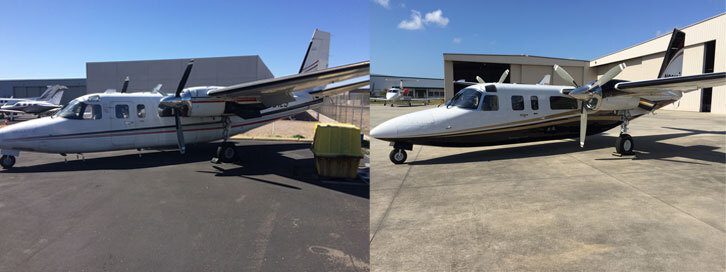
The 980 that had sat on a tarmac for more than a year and after Binnette’s refurbishment.
Steve Binnette remembers his days in the 1980s as a young, recently minted commercial pilot flying Commander 680FL and 500-series piston twins on freight runs out of Denver, Colorado. The exterior paint on the airplanes had long since faded, the interiors featured plywood floors and fiberglass-panel walls, and the geared, IGSO-540 engines on the FLs were, well, geared engines. That utilitarian, 24/7, all-weather duty gave him an appreciation for the Commander’s stout construction and solid, safe flight characteristics—traits that would figure prominently years later when he went searching for a business and personal airplane to succeed his Cessna 421.
Binnette had owned, flown, and enjoyed the 421 for five years, but with children enrolled in out-of-state colleges and business to conduct in Des Moines, St. Louis, and Champaign, Illinois, the Southern California resident needed more. He admits to suffering from “the airplane fever. I always thought about it—bigger, better, faster. I wanted more range, and more speed. Coming back from Iowa in the 421 in the winter with a 100-knot headwind was brutal. I was going 100 knots over the ground.”
Binnette is used to flying faster, and longer. He learned to fly in 1979, after quitting college and going to work in construction. Flying opened a new world of possibilities, so he quit his construction job, went to work at a local airport, and completed his four-year degree at Parks College in East St. Louis.

Avionics panel before and after
His first job out of college was managing a flight school, where he earned all the necessary certificates and ratings to pursue a career as a professional pilot. The airlines were furloughing pilots at the time, so Binnette found work at Combs Freight Air in Denver flying Commanders and, later, Convair 440s. Next came Frontier Airways and Convair 580s and, in 1985, was hired by American Airlines. Thirty-two years later he’s still at it.
Over the years at American Binnette has flown Boeing 727s, McDonnell Douglas MD-80s, the Fokker 100, Boeing 777s, and now the Airbus A321. He is the senior Airbus pilot for American, and these days does the Los Angeles to Hawaii run in an A321.
About midway through his career at American the airline began furloughing pilots. Although he survived those cuts he became convinced he should have a Plan B, so he and his wife founded a company that manages waste collection for corporate clients. They sold the company in 2006, and a few years later founded another, similar company. In 2012 they brought in partners who handle day-to-day management of the firm, freeing Binnette to concentrate on advanced treatment for his chronic ailment—the desire to fly a bigger, better, faster airplane.
Despite his long history flying turbofans, he was not convinced that was the answer for his business and personal flying. “The family said we should get a jet,” he says. “But a light jet doesn’t work for me. They are not much faster than some turboprops, and they have all kinds of limitations—they won’t go as far, or stop as good. The only thing they do better is go higher, above the weather.”

Binnette with son and friends
What he thought would work better was a turboprop—a Beech King Air, Mitsubishi MU-2, or a Twin Commander. He soon concluded that the Pratt & Whitney-powered King Air is slower and much less fuel-efficient than either the Honeywell-powered Twin Commander or MU-2. A King Air “just didn’t make any sense,” he says, so he focused on Honeywell-powered options, one of which emerged as a clear leader. “My earlier experience with Commanders left quite an impression on me,” Binnette says. “I wanted to get back into a Commander.”
That opinion was enthusiastically endorsed by a friend and former neighbor, Mark Dziubin, who at the time owned the last Commander 1000 built by Gulfstream Aerospace. Dziubin showed Binnette photos of the cockpit of his 1000 that he took inflight, with the GPS ground speed readout visible in the photos. Binnette was persuaded that even with those wintry, 100-knot headwinds on westward, homeward-bound legs, the Commander would be twice as fast over the ground as his 421.
So, Binnette’s bigger, better, faster airplane would be a Commander. But which model? Long range was a primary requirement, so he focused on the later-model JetProps with the longer, wet wing and increased fuel capacity. He also preferred the landscape window in the passenger cabin of an 840 or 980 to the smaller window on the 900 and 1000. The clincher was the 980’s larger baggage capacity.
With the help of Bruce Byerly, then with Naples Jet Center, Binnette found a 980 that was involved in a bankruptcy and had sat on the tarmac for more than a year. It needed just about everything—the engines were timed out, fuel was leaking from the wing, the rudder needed repair, and what was left of the interior was a mess. But the price was right. Binnete bought it, and gave it to Naples Jet Center to bring it back up to contemporary standards of appearance, performance, and flight management.
Today Binnette enjoys flying his bigger, better, and faster 980 out of his base at Camarillo, California, to business appointments in the Midwest; to visit his kids in college; and to hunting, skiing, and getaway vacations wherever the family chooses.
To his delight, his fever is proving contagious. One daughter has soloed, and a son earned his Private certificate while still in high school and is now working on his multi-engine rating.

